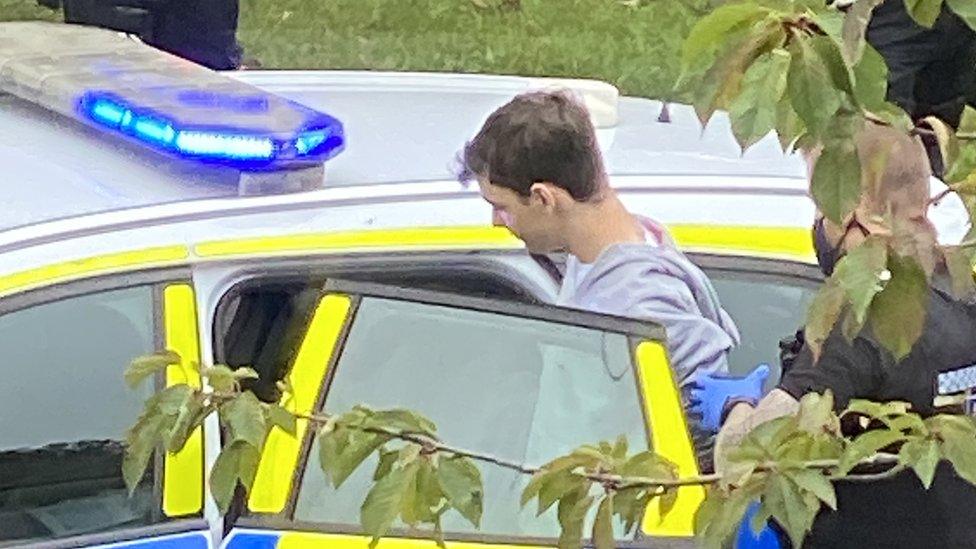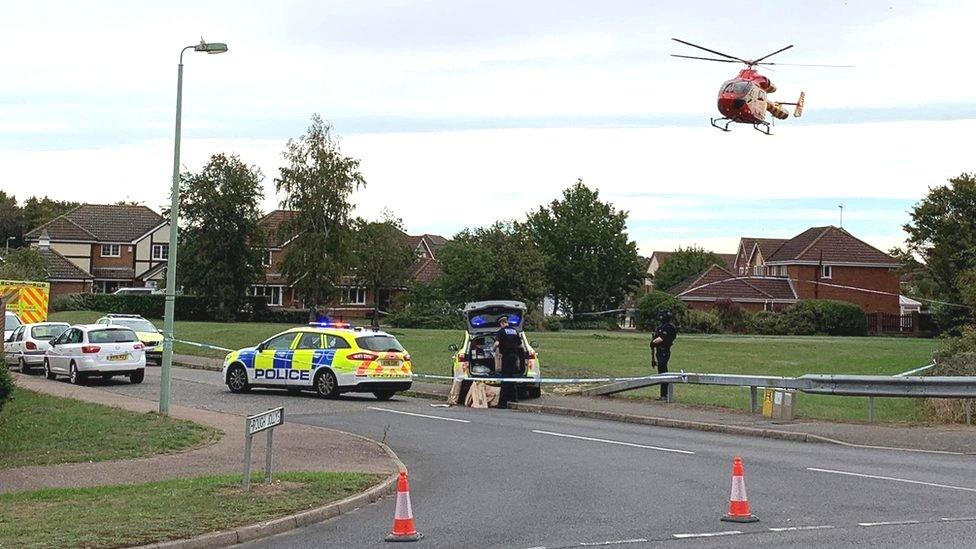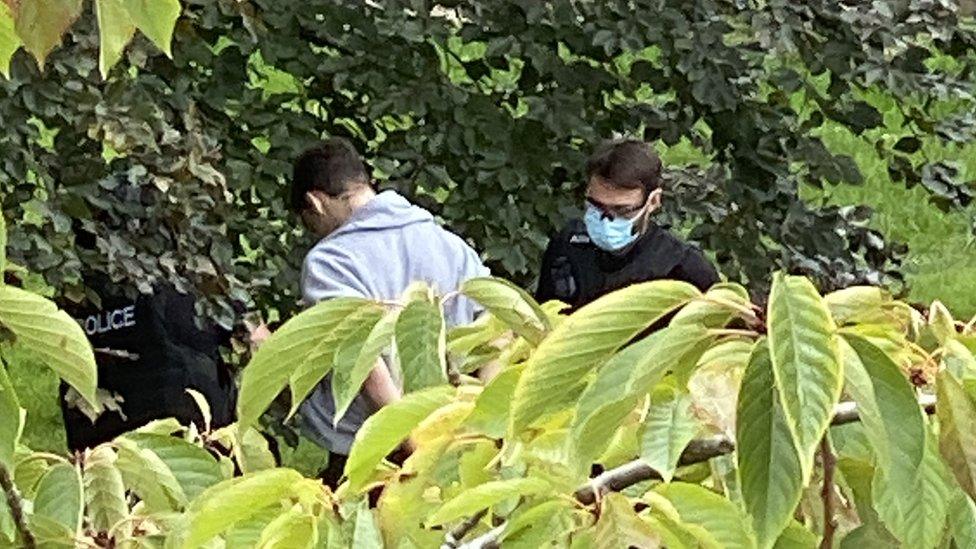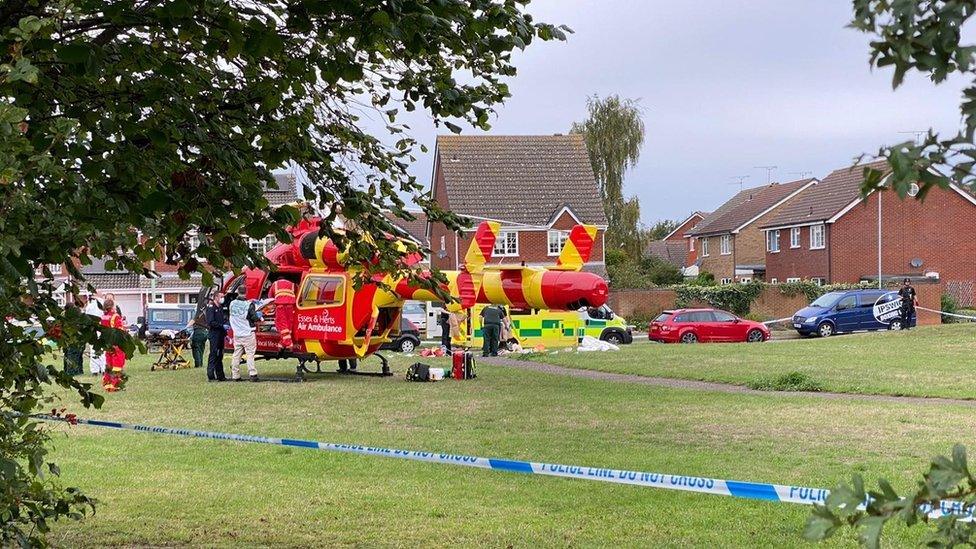Kesgrave schoolboy shooting: Teen was obsessed with games and guns
- Published

Jacob Talbot-Lummis "ruthlessly executed" his plan to attack his victim, the judge said
A 16-year-old boy has been sentenced to 24 years in custody for attempted murder. What drove him to lay in wait for an hour before shooting his friend in the face as he walked to school?
"I've done what I wanted to do, scummy as it is," Jacob Talbot-Lummis, told police after shooting his friend. "I will 100% co-operate with you."
Talbot-Lummis, 16, had taken his grandfather's Beretta shotgun and his father's silver car and lay in wait in Kesgrave, near Ipswich, for about an hour for his 15-year-old victim on 7 September 2020.
When the boy emerged on his journey to school for the first day of the new term, he spoke with him briefly, pulled out the shotgun and fired it into his victim's face.
Police arrested Talbot-Lummis later that morning in Westwood Avenue in Ipswich. He has been sentenced after being found guilty of attempted murder.
During the six-week trial, the court had learned the two boys had known each other since primary school and were believed to be friends at the time of the shooting.

The shotgun used in the shooting was an over-and-under Beretta
The victim, who cannot be named for legal reasons, remembers hearing a bang and falling to the ground.
He was still conscious and remembers Talbot-Lummis standing over him, not looking bothered as he lay bleeding in the street.
Taken to Addenbrooke's Hospital in Cambridge, the victim has been left with devastating and life-changing injuries after suffering a stroke. He remains partially paralysed.

Guns

Police arrested Jacob Talbot-Lummis on the morning of the shooting
Talbot-Lummis told the trial jury he had two main interests: Video games and clay pigeon shooting.
His interest in guns, he said, began "at quite an early age".
By the time he was arrested he had a "haul" of lawfully-held BB guns in his bedroom.
The trial was told how Talbot-Lummis was filmed in March 2020 in a video clip pointing an air rifle at the camera, which was being held by the victim.
"I will shoot you, I promise," Talbot-Lummis says in the clip.
According to Talbot-Lummis, the video was merely him and his friend messing around.
"It's quite normal," he said. "It's a quote from a meme, I'm saying it in a funny accent."
On another occasion, after messages at 01:30 BST to the victim went unanswered, Talbot-Lummis responded: "So you have chosen death."
"It's a quote from a meme, maybe Lord of the Rings," he told the court.
Yet, despite his fascination with firearms, Talbot-Lummis had claimed in court he never meant to shoot his victim, who he had known since primary school and at whose house he had stayed on a number of occasions, only to scare him.
In sentencing, Judge Martyn Levett said if Talbot-Lummis had only meant to scare his victim, he could have chosen one of his air rifles, rather than a shotgun.
Det Supt David Henderson said Talbot-Lummis "had experience of using shotguns, so his claim that the gun fired accidentally seems extremely unlikely".

Suffolk Police said the defendant and victim were at school together and had previously been friends
During the trial, firearms expert Mark Robinson said he examined photographs of the boy's facial injury and carried out laboratory testing, firing the gun from different distances into a card to see the pattern of the pellets.
Based on this testing, he told jurors: "The very instant the trigger was pulled, the muzzle of the gun was somewhere between 0.75m (2.46ft) and 1.5m (4.9ft) from the victim's face."
Mr Robinson said that testing with weights found that the force required to pull the trigger to fire the top barrel was between 3lbs 12oz (1.7kg) and 4lbs 4oz (1.9kg).
"It's not, by any stretch of the imagination, a hair trigger," he said.
The trial jury heard claims by Talbot-Lummis that the victim had bullied him and a mutual friend of both boys told police how Talbot-Lummis would often speak of how the victim would "bully him" and "slap" him over the head at school.
Despite this, the friend said, the pair remained friends and Talbot-Lummis had not raised any concerns about bullying with the school.
Judge Levett said he did not believe the bullying was "bullying of the scale or the degree suggested" by Talbot-Lummis during the trial.
Jurors were shown messages sent from Talbot-Lummis's Snapchat account to the injured boy about a week before the shooting.
In a series of messages, Talbot-Lummis wrote: "How is my fav little fatty doing/ Answer/ Me/ Boy/ Mmmmm so you have chosen death."

Computer games

Jacob Talbot-Lummis was arrested after the attack on the first day back at school after the summer holidays
Talbot-Lummis wore a virtual reality (VR) headset to play the game Blood Trail.
Released by San Francisco-based game-maker Electrovore, Talbot-Lummis played the game the day before the shooting, the court was told.
A friend of the defendant said the game was "hyper-realistic in its violence", and that Talbot-Lummis "adores it".
Judge Levett told how Talbot-Lummis had developed an "obsessive interest in all kinds of firearms and had become entrenched in watching computer games online".
It was an obsession, the judge said, which began when he was nine years old. He said he had been "playing games in a virtual world more suitable for 18-year-olds".
He said that playing such games "was a factor for the onset of violent fantasies you had".
The judge voiced concern about "the frequent glorification of shooting a character on screen".

Psychologist Prof Andy Przybylski said violent computer games could be in the "milieu" of a person committing an act of violence
Prof Andy Przybylski, director of research at the Oxford Internet Institute, co-authored a recent study which found no causal relationship in adolescents between playing violent video games and heightened aggression in real life, external.
The study did find that people with higher levels of aggression were often drawn to more violent video games.
"At least since the mid 1970s, psychologists have been expecting a causal relationship or something that links violence on an LCD screen and violence in the real world," he said.
"But whenever we share our work and our data, when we dot our 'i's and cross our 't's we don't find any evidence of that.
"It doesn't mean that everybody should be playing violent computer games but we have to ask ourselves whether this is a matter of taste or a matter of science.
"More kids play video games than wear socks."
Although he could not comment on the specifics of the Talbot-Lummis case, he said Judge Levett's remarks were welcome.
He said violent computer games could be in the "milieu" of a person committing an act of violence.
"People gravitate towards their interests," Prof Przybylski said. "People with higher levels of aggression tend not to be disgusted by violence in video games."
The BBC contacted Electrovore for comment but the firm has yet to respond.

The boy was shot in Kesgrave as he walked to school in September 2020
Before he was sentenced, Talbot-Lummis took part in an activity at a secure unit.
According to his pre-sentence report, Talbot-Lummis was asked: "What will you do when you leave here?"
He responded by saying he would "probably kill again", the report said.
Talbot-Lummis was told that on his release from custody he would spend a further five years on licence.

Find BBC News: East of England on Facebook, external, Instagram, external and Twitter, external. If you have a story suggestion email eastofenglandnews@bbc.co.uk, external
Related topics
- Published3 September 2021

- Published25 June 2021

- Published9 June 2021

- Published1 June 2021

- Published20 May 2021

- Published7 September 2020
